Your email call to action is what determines whether your cold outreach actually hits your goals, or simply gets ignored.
To help you write the best cold email CTAs you can, we analyzed the most successful lemlist cold email campaigns and isolated the characteristics of the highest-conversion CTAs.
Consider this your guide to CTAs that get replies and book meetings.
What is a CTA in cold outreach?
A CTA, or call to action, is a string of text, button, or hyperlink that drives the reader to take a certain action. In a cold email, it’s typically placed at the end of the message, before the signature, and invites the recipient to respond, click the link, buy a product, or otherwise take the step you’d like them to take.
When you start writing calls to action for your emails, it’s important to understand their purpose and intent. In other words, what do you want to accomplish?
You will use different strategies for different goals. For example, a CTA driving people to sign up for a free trial will not look the same as one that is warming up leads through cold email.
Your cold email copywriting plays a huge part of this as well. Use the copy to set up the pitch and draw interest, then have your email CTA ready as a gateway to drive action and guide your prospect through different stages of your funnel.
Wondering how to do that? Let’s get into cold email CTA best practices.
How do you write an email call to action?
Here are some tips to keep in mind when you write your cold email call to action. These are based on an analysis of millions of successful lemlist cold email campaigns, so that you can pinpoint exactly what works.
Tip #1: Align the call to action with your pitch
Writing your email’s call to action is only one piece of the puzzle. Even if you copy the most creative CTA that had a great conversion rate, it will fall flat if it doesn’t match your product and messaging.
So before you jump in on an amazing call to action example online, ask yourself: What pain point are you solving?
You’ll have to do your homework. Craft a pitch that addresses this specific pain point and shows the prospect exactly how you’ll solve it.
Prospects won’t click if the pitch that leads up to it doesn’t draw them in, even if your CTA is amazing.
If you need help putting together the perfect pitch for your cold outreach, use this list of 10 high-conversion sales pitches to get inspired.
Tip #2: Only use 1 call to action per email
According to a study by Unbounce, emails with only 1 CTA performed 371% better than emails that have multiple CTAs.
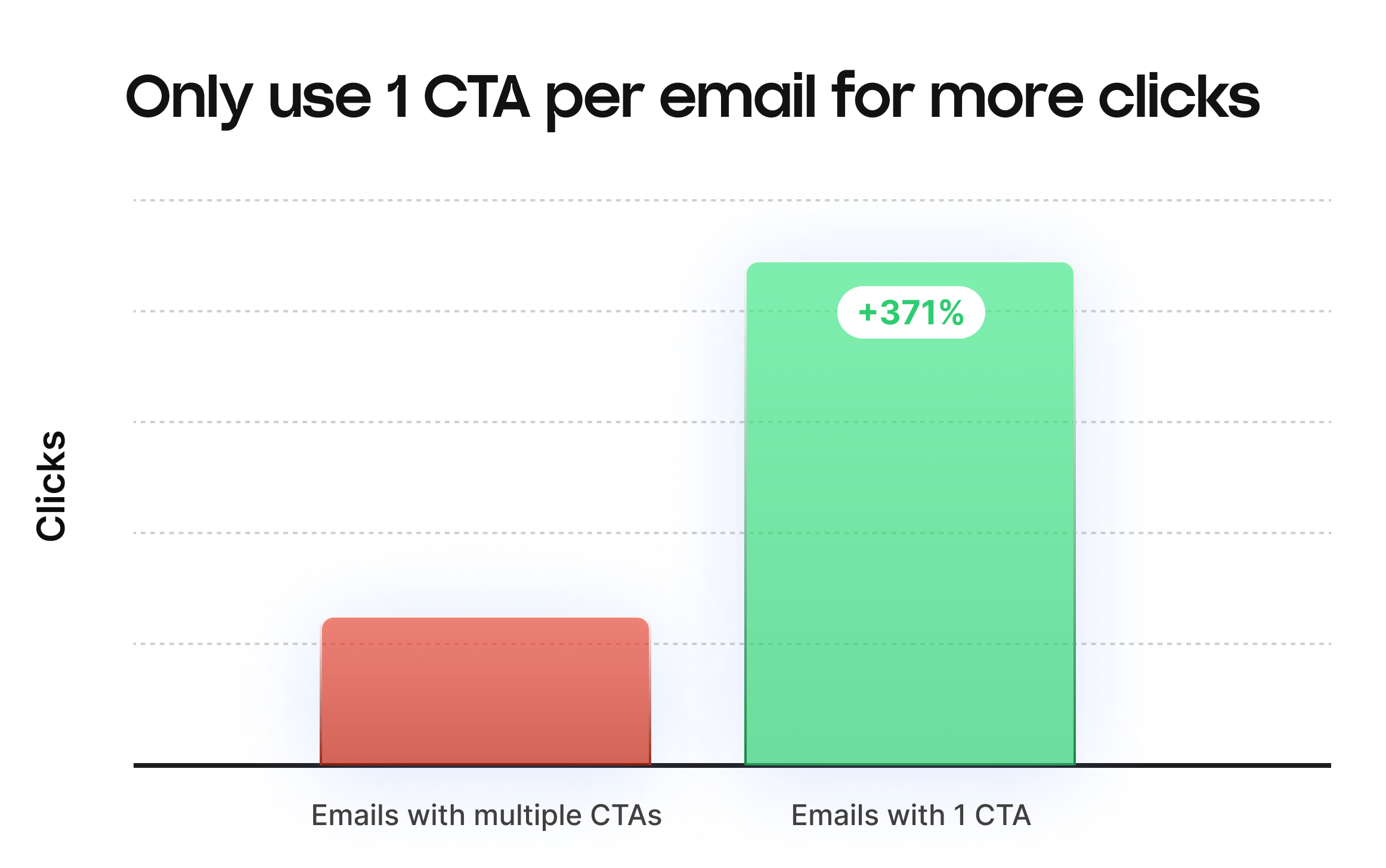
Why is that?
People typically don’t read their emails very closely – they skim.
So if your call to action isn’t one clear step for the prospect to take, they’re less likely to follow through.
When you pack your cold email with multiple links to click and actions to perform, odds are your prospect will either ignore them all, or only do the minimum.
So don’t distract your prospects with too many CTAs. Pick one action that you want them to take, and focus your email copy on that.
Tip #3: Make sure your CTAs are clear and visible
Nobody likes being overwhelmed with content. It’s confusing, inefficient, and forces prospects to think longer than they want.
It’s the same set of rules for CTAs. Always make them look clean, visually appealing, and with enough space to set them apart. You want your CTA to stand out.
Don’t forget to take into account multiple formats, like desktops, tablets, and smartphones. Your CTA should be clean and visible on smaller screens as well.
Tip #4: Keep your cold email CTAs short and direct
According to our analysis of millions of cold email campaigns, the best length for a cold email CTA is between 4-8 words.
To measure this, we isolated calls to action that included hyperlinks, and we took the average click-through rate for different lengths of CTAs.
In doing so, we found the highest CTR came from 6-word calls to action, with an overall sweet spot between 4 and 8 words.
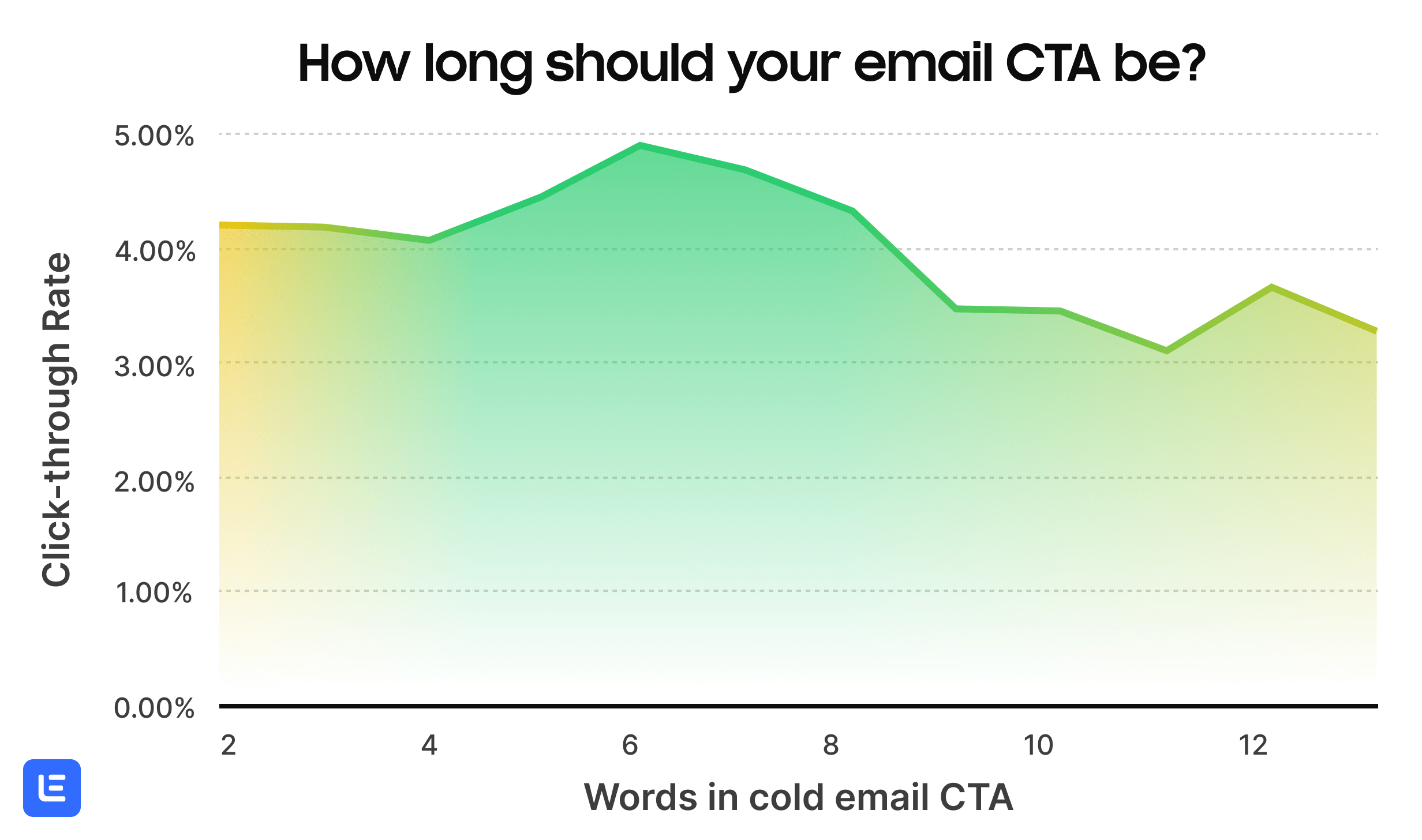
Now, this doesn’t mean that you need to make every single cold email CTA 6 words. Keep in mind that we only measured CTAs with links, so CTAs that simply ask for a response may perform better at different lengths.
The lesson here is to keep it short, so that the prospect understands at a glance what action they need to take.
Tip #5: Personalize your call to action
According to another study, personalized calls to action performed 42% better than CTAs that weren’t personalized at all.
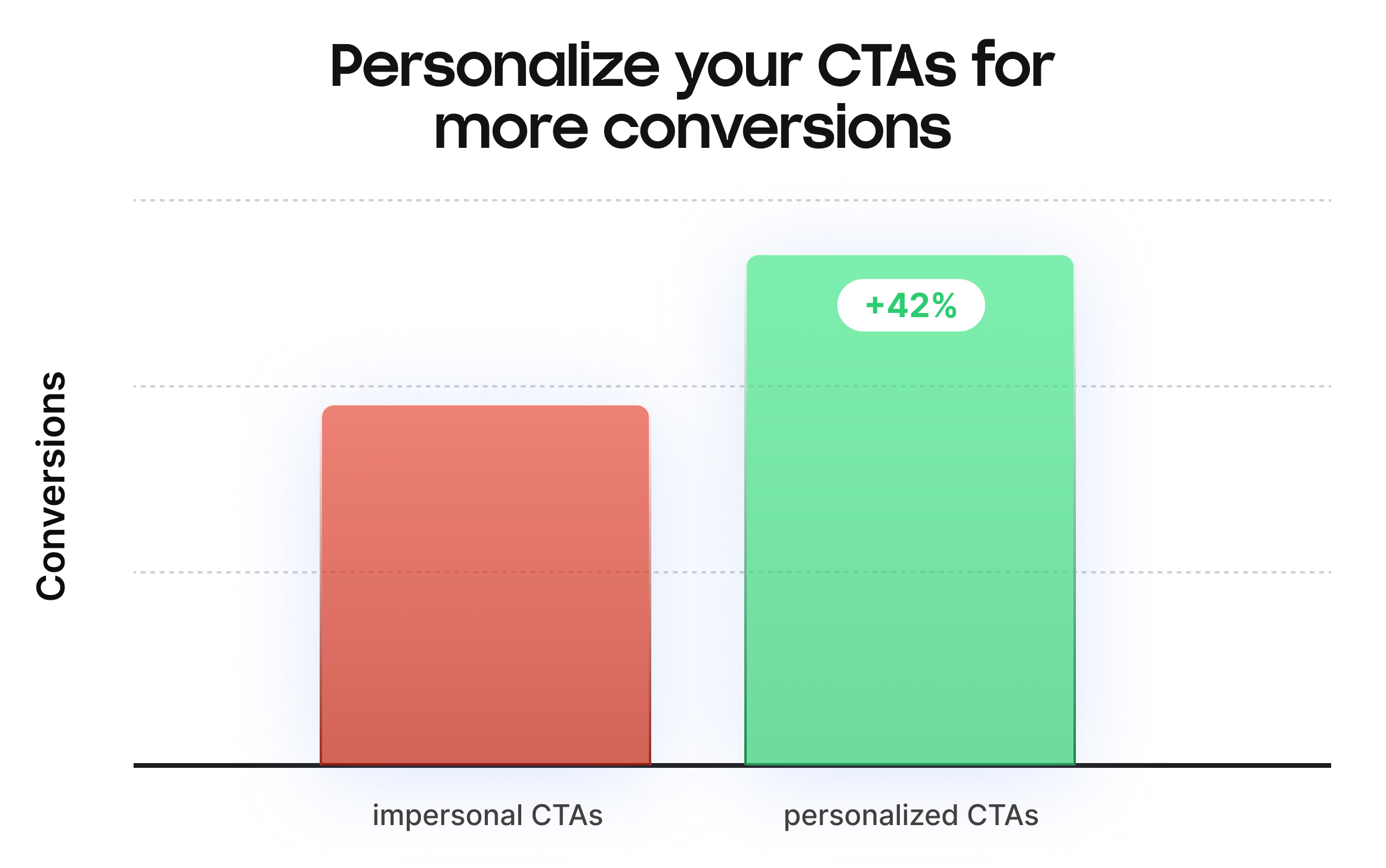
What does this mean?
An impersonal CTA is one that does not take into account the buyer’s journey, the prospect’s interests, your own brand, etc. In other words, it means using a generic “book here” or “shop now” as your call to action.
Personalized CTAs are different for every prospect, or every segment. They speak directly to the prospect and are tailored to their unique pain points.
For example, you can get creative and use humor, or play with emotions. Imagine the anger or frustration you feel on a landing page that uses pop-up calls to action. You could make a better, personalized CTA for that kind of page by using copy like “Nobody likes popups,” or “tired of popups?” and using that to lead into your action.
You could also use your CTA to outline a clear benefit of the action – or to minimize the risk of taking it. For example, “start booking more meetings now,” or “book a meeting here – it’ll take 15 minutes, tops!”
Overall, to have high-conversion, personalized CTAs, you should:
- Make a clear value proposition that makes your customer say “YES!”.
- Make it EASY and FAST for them to say yes and click that link, or respond to your email
With these tips in mind, let’s move on to some great CTA email examples, and why they work.
11 email call to action examples
Here are 11 cold email CTA examples with high success rates.
As you look at these calls to action, keep in mind that each of them is tailored to a specific pitch included in the rest of the email.
For best results in your cold outreach, don’t just copy and paste these CTAs into your own campaigns. Instead, consider what makes them work in the context of the emails, and think about how you can do the same.
1. “Check out the new guide right here”
In this example from Backlinko, Brian Dean is pushing the recipients to download his new guide to building up backlinks in SEO articles.
The content of his email is written exactly like one of his SEO-optimized articles, which means it’s well-targeted for the reading habits of his target audience. It’s also clear, with a simple backstory and 4 distinct benefits of downloading the guide.
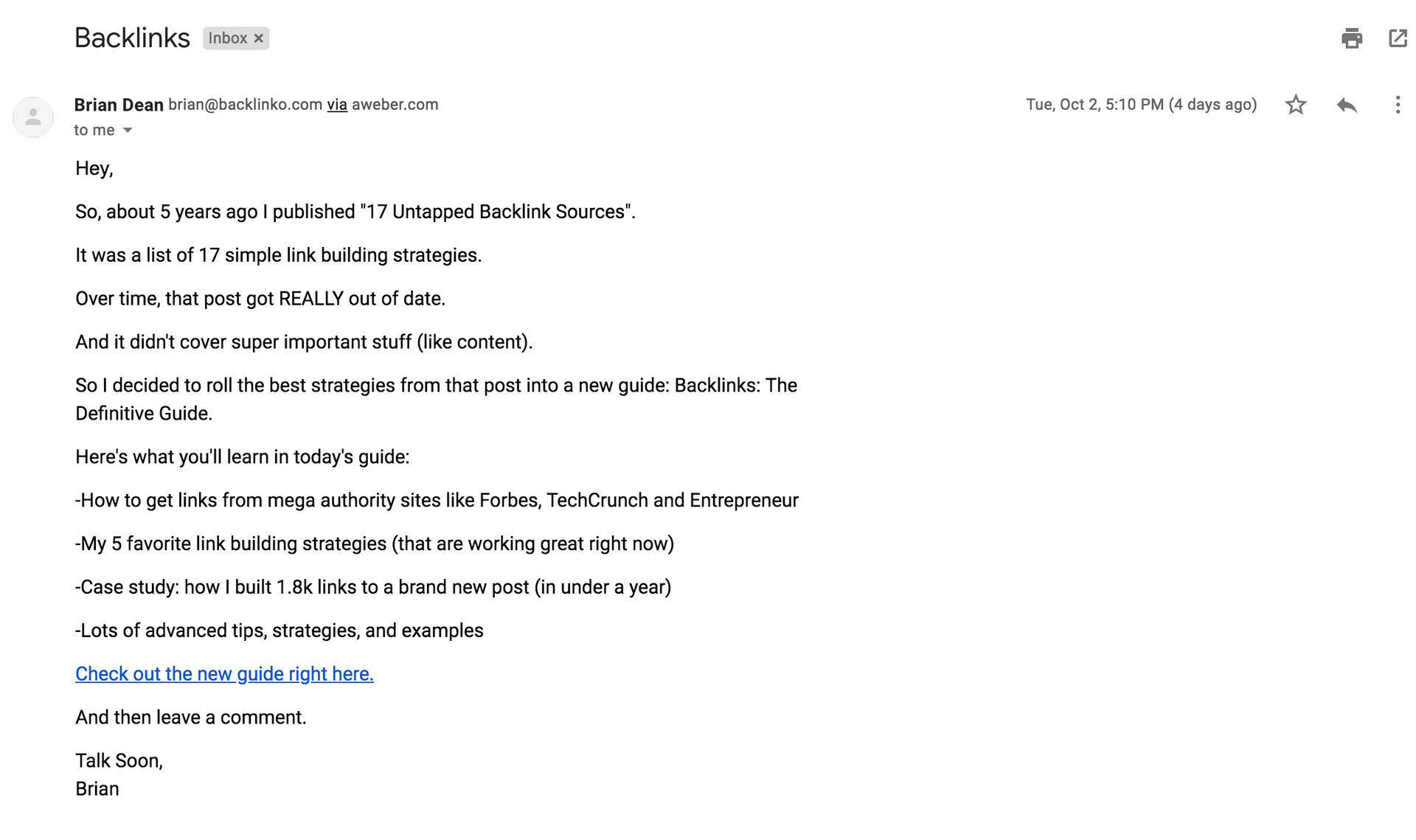
Why this email CTA works:
- The blue hyperlink text stands out from the rest of the email
- The instructions are short and easy to follow: “click for a new guide”
- The CTA matches the tone of the rest of the email
- It is a match for his target audience, looking for new and innovative ways to get more backlinks
2. “Drizzy’s back. Listen now.”
An out-of-the-box example from Spotify, this email gets right to the point.
Without any unnecessary lead-in, or even a greeting, the email starts with a bold graphic that draws your eye.
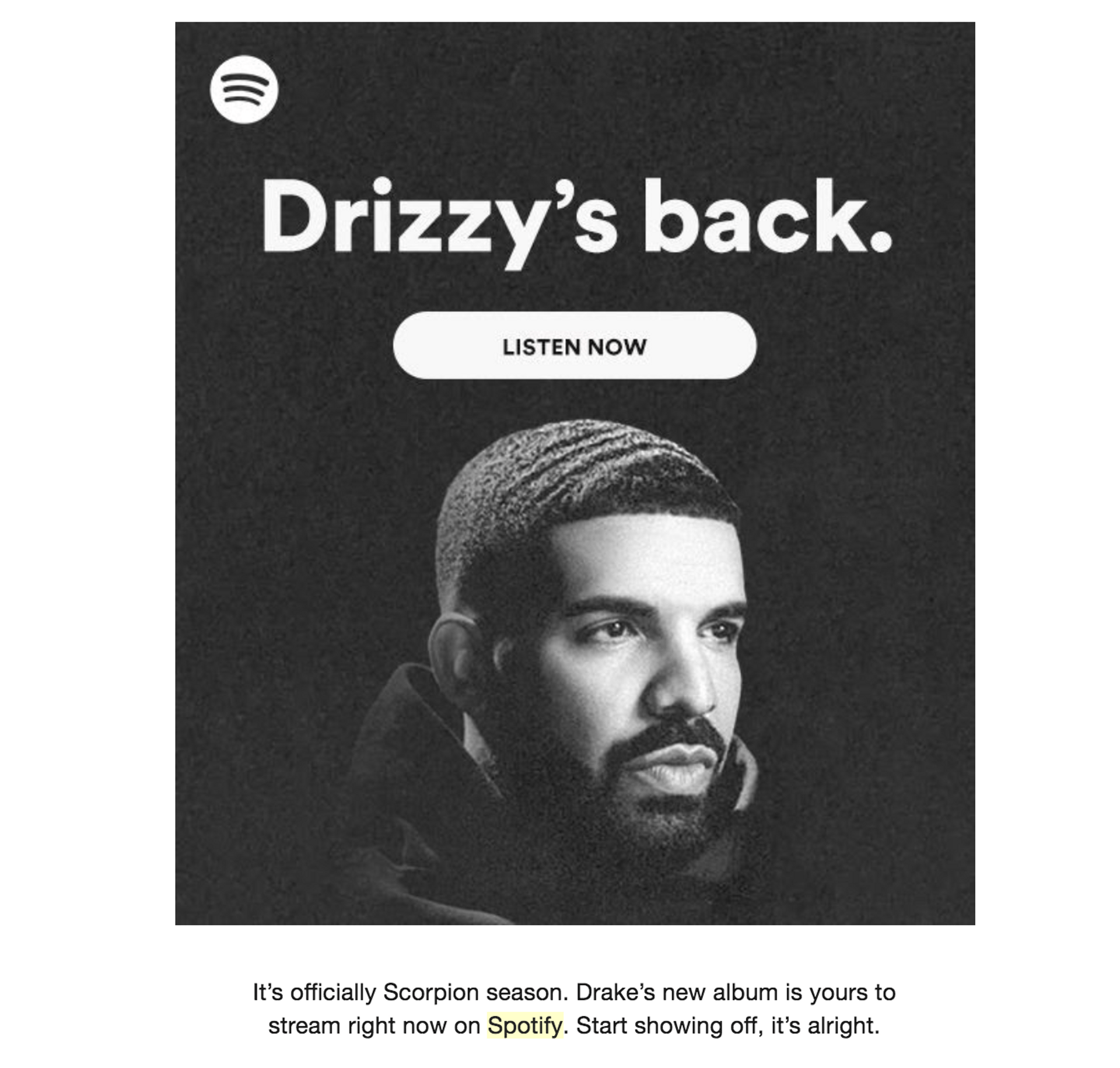
Why this email CTA works:
- The clean “listen now” button stands out in the middle of the page
- “Listen now” may seem generic, but it works as it’s paired with personalized language Drake listeners would actually use
- The rest of the email is simple, letting the graphic and CTA take all the attention
3. “Smells like team sprint”
Here’s an example of some classic email marketing brilliance by InVision, promoting a new guide to team sprints for companies of all sizes.
It’s a design-heavy email, with a banner image that is intriguing and tells a story of business owners who are gearing up for important tasks.
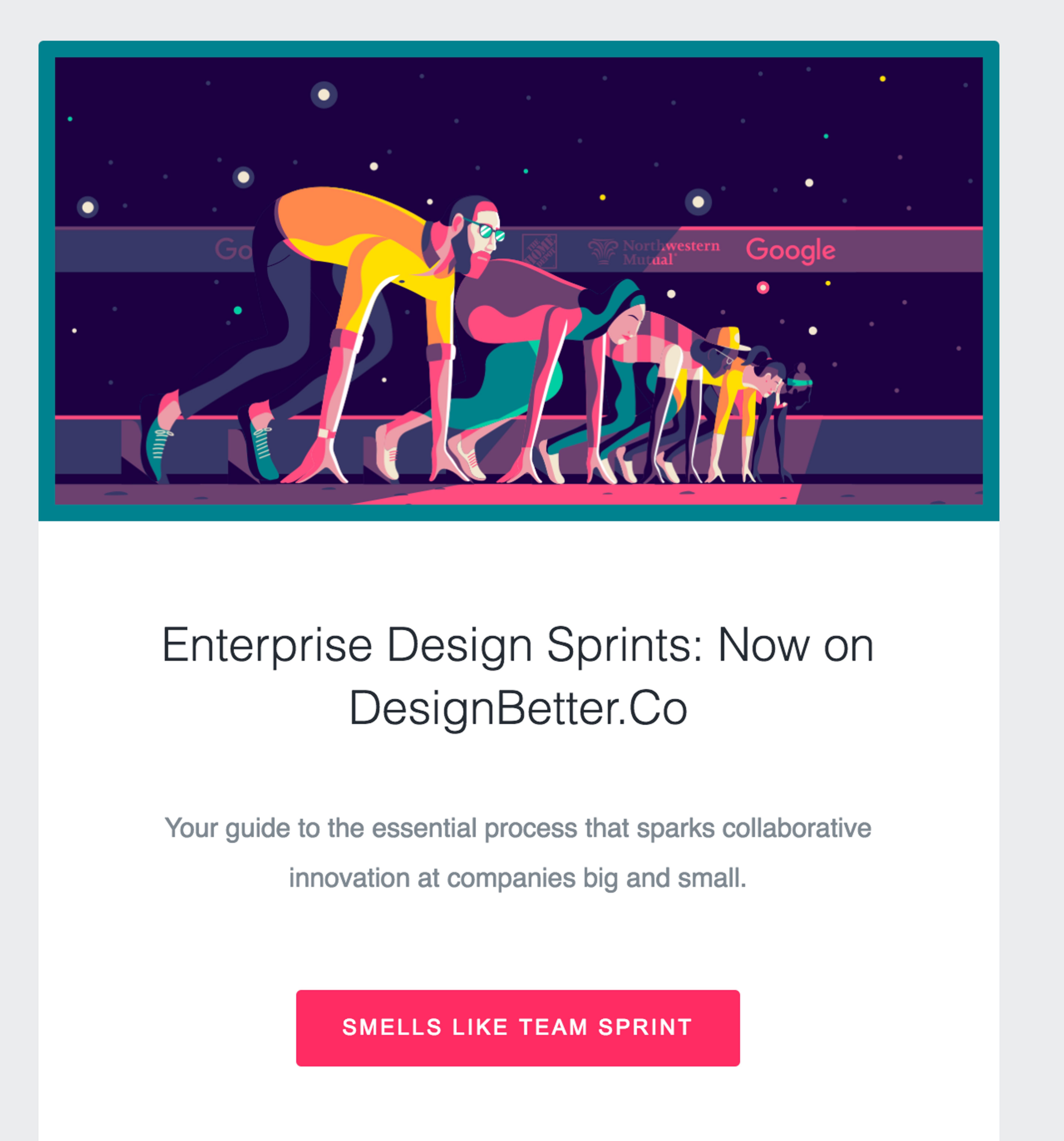
Why this email CTA works:
- The CTA button is bright and colorful, standing out from the rest of the email
- “Smells like team sprint” is a fun little pun that sets it apart from basic CTAs like “click here” or “download now”
- While the CTA itself doesn’t describe the action you should take, the rest of the email supports the CTA by describing the guide and leading the reader to it
4. “WATCH THE WEBINAR”
This next email is from one of our own marketers, reaching out to leads who have already signed up to use our cold outreach tool, lemlist.
The aim of this message is to help new leads accomplish the goals that drove them to sign up for lemlist.
Hi {{firstName}},
There’s a TON of videos on our Google Drive with our clients saying…
“Cold emails are hard. My reply rate sucks. I personalized my emails, but it’s still not working”.
If this is you, keep reading.
The thing with cold emails is that we all get so many of them it’s insane. Half of these are trying to sell us some crap we don’t even want. But this doesn’t mean they don’t work.
I put together a 100% FREE video that walks you through:
– How to create and segment out lists of HIGHLY TARGETED prospects
– How to personalize your emails twice as fast
– How we got 44 qualified meetings with one single emailWATCH THE WEBINARThere’s no opt-in, just go and watch it.
Have a good one {{firstName}},
Vuk
Why this email CTA works:
- Similar to the Brian Dean example, the language is simple and clear
- It’s short: only 3 words
- The rest of the email builds up to the CTA, covering its benefits and the pain point it will address
- Right after the CTA, you’ve got an objection-smasher, “no opt-in,” so the prospect has no reason not to click
5. “If you’re interested, shoot me an email!”
The first email call to action on this list that does not include a link, this example came from a cold email that landed in our inbox and caught our eye.
In this email, Adrien sends value from the start, with a video that includes advice on how to improve lemlist’s brand presence on YouTube. The combination of an engaging pitch, valuable content, and an easy CTA hooked us immediately.
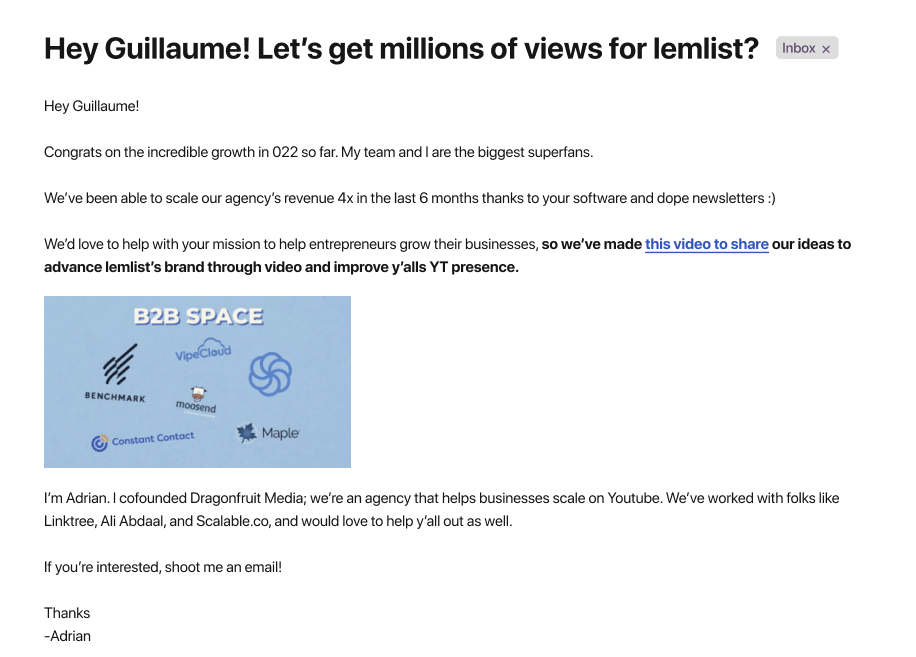
Why does this email CTA work?
- There’s only one, which gives the prospect clarity on which step to take
- The CTA doesn’t ask for much effort (a simple reply to an email is enough)
- They kept the tone casual by using “shoot” instead of “send,” which is how friends talk
6. “Just pick a time here: lemcal.com/myname”
Here’s an example of an A/B test we did to test whether it’s best to propose a specific meeting date in your email CTA, or to use a scheduling app.
In our test, we sent two versions of the same email: one with a CTA that suggested a specific date and time, and another with a scheduling link that allowed the prospect to choose their own time.
In this experiment, the email with the scheduling link resulted in 1.5x more meetings than the email without one.
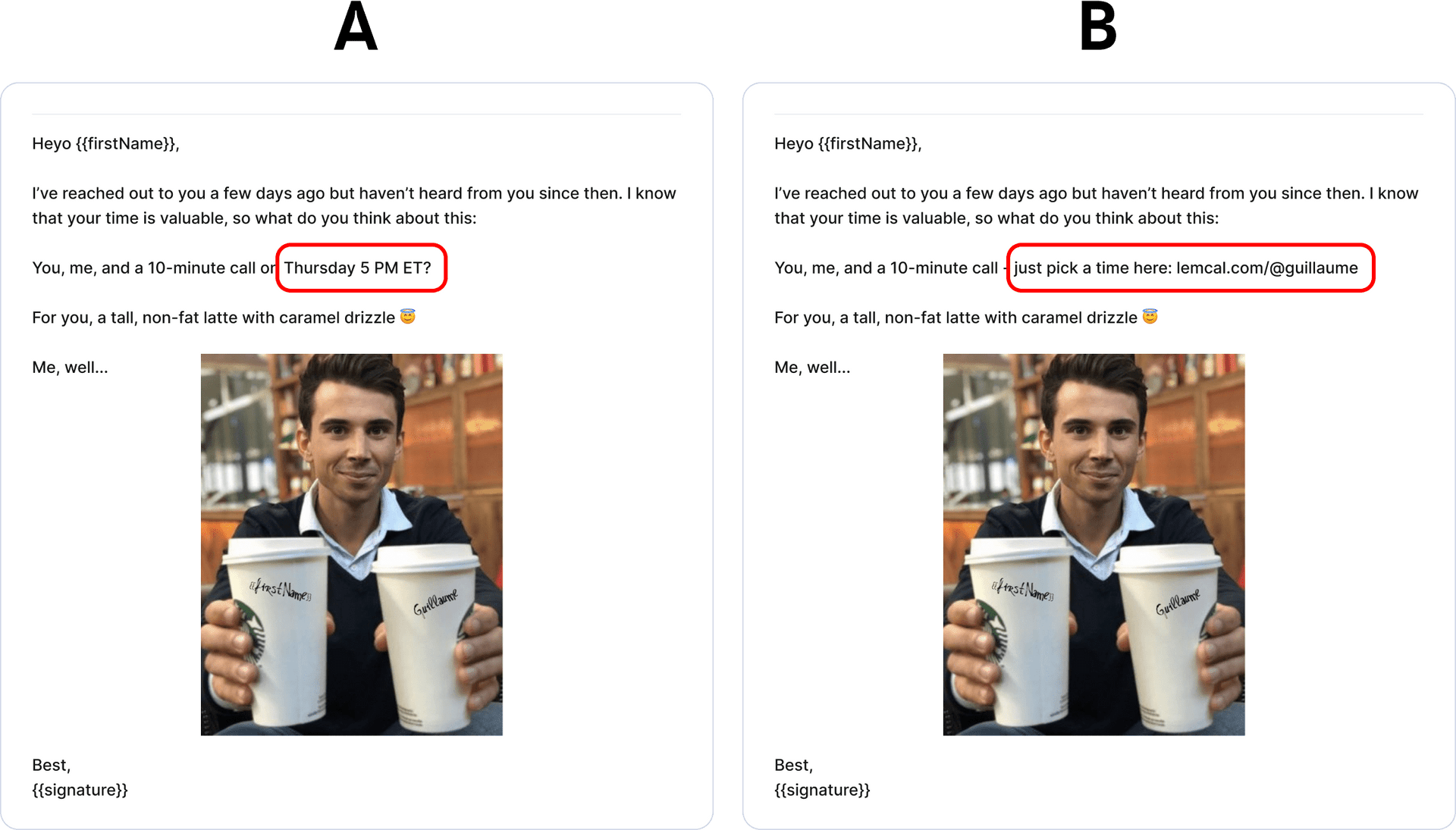
Why this email CTA works:
- The email copy is friendly and engaging, and with the right targeting it inspires the reader to book a meeting
- Using scheduling links like lemcal stops the back-and-forth of trying to find the right time for a meeting
7. “Would you agree?”
In this case, instead of proposing a specific step, this CTA drives prospects to respond by asking them an engaging question.
The first line catches attention by getting right to the point, and the rest of the email is well personalized to the prospect by using their specific name, event, and the technology they use.
To see a full explanation of why this cold email works, read this email tear-down for selling software.
Just reviewed {{Company.Name}}’s “{{Event.Name}}” recording. Hands down top-notch content you have cooking over there, {{First.Name}}.
Looks like you chose {{Technology}} to host the event. Word’s on the market that their ROI calculation side could use a boost.
Would you agree?
Cheers,
{{signature}}
Why this email CTA works:
- It’s a “light” CTA that doesn’t require to prospects to click a link or book a meeting
- The call to action confirms the reader’s interest before moving forward to giving more information
- The rest of the email is targeted to the prospect’s specific interests
8. “Does this resonate with you, or am I off-topic?”
This CTA is also going for a reply, instead of another action like a click or a meeting booked.
The email uses liquid syntax to hyper-personalize the greeting, and the rest of the email focuses on the prospect’s recent activity.
To understand how the CEO of devlo sales development agency wrote this post, read this cold email tear-down on using prospects’ pain ponts.
{% assign ampm = “now” | date: “%P” %}{% if ampm contains “am” %}Good morning{% else %}Good afternoon{% endif %} {{firstName}},
Saw your last LinkedIn post about your last real estate project in Lyon, where you invested in these luxurious apartments. They look fantastic.
The reason I’m contacting you is that dozens of real estate investors were struggling to find worthwhile projects before working with us. They didn’t have enough options to choose from, and their previous partners weren’t reliable enough.
These investors, including [CurrentClientName], work with us now to constantly fuel their portfolio with new properties. It’d be great to give you a bit more context.
Does it resonate with you, or am I off-topic?
[Name]
Why this email CTA works:
- Again, this is a non-pushy CTA, seeking interest instead of a meeting
- It allows prospects to reply in both the positive (”it resonates with me”) or the negative (”you’re off topic”) – either way, garnering more replies that you can nurture into a conversation
9. “Perhaps this day is good for you? Let me know.”
Used in a networking email, this is a longer CTA that is aiming to continue the friendly tone of the beginning of the email, and invite the reader out for a coffee.
To learn more about the strategy behind this email, dive into this cold email tear-down for networking via cold outreach.
{% assign ampm = “now” | date: “%P” %}{% if ampm contains “am” %} Good morning {{firstName}} {% else %} Hope you are having a good afternoon, {{firstName}}. {% endif %}.
I just gave you a call but I couldn’t reach you. I have just moved to (city) and would love to know a little more about {{companyName}}.
Do you have a few minutes to catch up next week? And if you do, do you take your coffee in person or virtually?
Perhaps next {SPIN DAYS} is good for you? Let me know either way.
Best,
{{signature}}
Why this email CTA works:
- It offers a specific time for the prospect to meet them, with flexibility if they need to reschedule (Note: one way we might make this better is by adding a scheduling link!)
- As a meeting can be a big ask on a first email, the beginning of the message underlines that it’s a casual chat, which won’t take much effort on the prospect’s part
- The CTA is friendly and open, matching the rest of the email.
10. “Would you be interested in integrating your stack with a single platform?”
Another interest-based call to action, this one refers to a specific benefit the prospect will receive if they respond.
The rest of the email builds up to this CTA by making it all about the prospect with several liquid variables, and by backing up their claim with social proof.
For the full breakdown of this email, check out the tear-down of cold emails for CTOs and CIOs.
Subject line: Intro
Hi {{firstName}},
I saw you’ve implemented {{tool1}} and {{tool2}} at {{companyName}}. How do you integrate both?Just last week, I was discussing with {{firstNamesRef}} from {{similarcompany}} how the integration between {{tool1}} and {{tool2}} had impacted these operations thanks to {{mycompanyName}}.
Would you be interested in integrating your stack with a single platform?
Kind regards,
{{signature}}
Why this email CTA works:
- It asks only for interest, not a time-consuming meeting or download
- It is personalized to its audience of CTOs and CIOs by addressing a need and using their own language (”integrating your stack”)
11. “Think this could help your team?”
Finally, one last interest-based CTA that illustrates how important it is not to simply copy and paste popular calls to action. Instead, you have to tailor it to your pitch and your target audience.
In this example, the question suggests that the sender has a perfect solution for the prospect’s unique problem.
For more in-depth information on this example, take a look at this cold email tear-down for getting replies from PPC advertisers.
Subject line: Hey, I have an idea for {{Company}}
Buongiorno {{Firstname}},
I saw you’re running ads on facebook, I assume you’re looking to secure new patients as the team continues to grow?
Not sure what your experience advertising is so far, what we hear from most clinic owners is ads aren’t profitable anymore.
Our experience is quite the opposite. As an agency, we’ve helped +50 clinics get +100 qualified leads every month with instant forms (a specific type of ad).
Think this could help your team?
Happy {{day}}
{{Name}}
{{URL}}
Scaling Dental Clinics with Paid Ads since 2020
Why this email CTA works:
- It is short and simple (only 6 words)
- It stands out from the rest of the email, as the shortest paragraph and a clear question
- It’s a simple request: just respond if you think this option would be helpful
Key takeaways
Did you get all that? Here’s what you should keep in mind when writing the calls to action for your cold emails:
- Understand the context of your CTA – what’s the goal and does it inspire clear action
- Depending on the channel, make it clear, easy to see and match the intent
- Work on your words, A/B test the language
- With CTAs in emails, a pretty design is nice to have, but messaging is essential
As we mentioned above, the key is to personalize your CTAs to the pitch and to your message. Many of the successful examples did this with text and image variables and liquid syntax.
To get your hands on a tool to help you personalize your emails and increase your CTA conversion rates, give lemlist a try.
Your source of actionable outreach tips and strategies that will help you get replies and grow your business.

